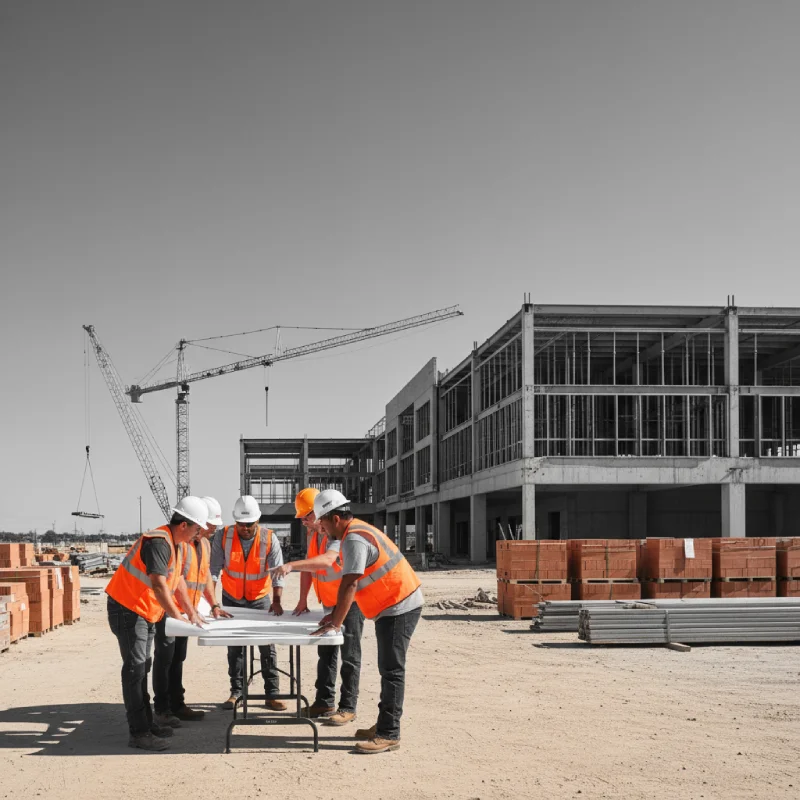
The future of Texas commercial construction is defined by technological integration, infrastructure expansion, workforce development, and sustainable building practices as the state leads the nation with strategic investments in semiconductor facilities, data centers, and smart construction methods.
Texas stands at the forefront of America's construction revolution. With massive infrastructure projects underway and federal programs fueling development, the state has positioned itself as the nation's undisputed construction leader. But growth brings challenges—workforce shortages, resource constraints, and rising expenses require strategic solutions.
Understanding where Texas commercial construction is headed helps businesses, developers, and property owners make informed decisions about their projects and investments.
Texas has emerged as America's construction powerhouse, commanding an impressive 16.5% of all non-residential and non-building construction contracts nationwide. This extraordinary achievement totals significant construction activity, propelling the state's economy within a decade.
The construction surge drives strong employment growth while supporting both public and private developments across residential and commercial sectors. Major projects include semiconductor facilities, data centers, and extensive urban development initiatives that reshape Texas communities.
Federal programs like the CHIPS Act and Infrastructure Investment Jobs Act further accelerate expansion. The residential construction market demonstrates this momentum with over 41,000 new permits issued statewide through recent quarters, signaling recovery from earlier market volatility.
Texas is experiencing unparalleled growth in technology-driven industrial construction, with semiconductor manufacturing and data center development leading the charge. These high-tech facilities are creating substantial construction contracts while establishing the state as a national hub for advanced manufacturing and digital infrastructure.
The Lone Star State has emerged as the epicenter of semiconductor manufacturing expansion. Major industry players are driving growth through massive commitments—Texas Instruments announced investments for multiple fabrication facilities, while Samsung is constructing major plants near Austin.
Strategic federal and state incentives accelerate this expansion. The state's manufacturing sector achieved record high investment in manufacturing structures, logging the largest contributions to real GDP growth in decades.
Digital infrastructure demands are reshaping Texas's construction landscape as data center investments surge to record levels. Central Texas capacity growth demonstrates the scale of technological infrastructure investment altering the commercial construction environment.
| Investment Timeline | Growth Indicators |
| National Projections | Substantial multi-year growth |
| Central Texas Capacity | Significant expansion |
| Under Development | Major megawatt additions |
| Metropolitan Impact | Tax revenue generation |
Major projects across the state demonstrate the scale of technological infrastructure investment. While these megaprojects create extensive short-term construction opportunities, they also signal the state's commitment to digital infrastructure leadership.
Workforce shortages have emerged as the most pressing challenge facing commercial construction services across the state. Contractors report significant difficulty filling hourly craft positions and trouble securing salaried professionals.
These shortages stem from multiple factors, including stalled immigration policies and persistent underinvestment in career awareness programs. The aging workforce compounds these challenges, while negative stigma around skilled trades hampers recruitment strategies among younger workers.
Industry collaboration has become essential, with companies expanding training programs and enhancing employee benefits to improve workforce retention. Despite recent job additions, growth cannot match surging demand. Education investment in vocational training remains critical for developing sustainable workforce pipelines.
Escalating construction expenses have emerged as a formidable obstacle for commercial construction services throughout Texas. Material expenses and labor account for substantial portions of total budgets, with regional variations affecting project planning.
Successful contractors now prioritize budget adaptability, incorporating annual inflation forecasts and strong contingency planning. Strategic budget allocation requires understanding that foundation work, interior finishes, and other components demand precise financial planning and flexible management strategies.
Texas's infrastructure faces unprecedented strain as rapid population growth and industrial expansion push existing systems to their breaking points. The state's electrical grid confronts explosive demand increases, with projections showing electricity needs expanding substantially by 2030.
ERCOT projects electricity consumption could increase dramatically, with peak demand potentially exceeding current capacity. AI data centers alone will add substantial new load, equivalent to powering millions of homes.
This explosive growth creates severe challenges for grid reliability and capacity planning. Traditional transmission planning cannot accommodate demand spikes occurring within short timeframes. The state faces potential annual deficits without substantial new investments.
Beyond electrical grid challenges, the Lone Star State confronts an equally daunting infrastructure crisis as water supplies dwindle while demand skyrockets. According to Autodesk's construction industry research, sustainable building practices and resource management have become critical factors in project planning as infrastructure constraints intensify.
Commercial construction projects must now prioritize water conservation strategies and innovative supply management solutions. Aging infrastructure loses substantial volume yearly through deteriorating pipes, while data centers will consume significant gallons by decade's end. Construction companies adapting to these realities will secure competitive advantages through water-efficient designs and alternative sourcing methods.
Today's industry leaders are embracing cutting-edge technologies that fundamentally reshape how projects are conceived, executed, and operated. Smart technology integration now drives automated lighting, HVAC systems, and security protocols, dramatically reducing operational expenses.
| Traditional Methods | Modern Technology Integration |
| Manual system controls | Automated smart building systems |
| Reactive maintenance | Predictive maintenance alerts |
| Standard construction | 3D printing and modular assembly |
| Basic project tracking | AI-powered workflow optimization |
| Energy waste concerns | Real-time energy management |
Research on construction automation demonstrates that AI platforms enhance project scheduling accuracy, while modular construction and 3D printing reduce waste and accelerate timelines. These innovations position Texas commercial construction for unparalleled efficiency and resilience.
Artificial intelligence platforms now enable predictive scheduling, automated task assignments, and real-time adjustments based on project demands. Computer vision technologies monitor construction sites continuously, identifying safety hazards and productivity optimization opportunities.
Federal tax incentives currently drive significant investment decisions across Texas's commercial construction sector. Section 179D provides commercial building energy efficiency credits for qualifying projects, while residential clean energy credits offer substantial coverage.
However, recent legislative changes are reshaping the landscape. Some programs face sunset provisions, accelerating adoption of alternative financing solutions that attach repayment to property tax assessments for building decarbonization projects.
Despite federal adjustments, sustainability regulations and renewable energy credits continue supporting Texas developers pursuing net-zero goals through innovative financing strategies and energy-efficient building methods.
As Texas solidifies its position as the nation's construction powerhouse, the state's commercial building sector stands ready for sustained expansion through the next decade. Texas maintains its commanding lead over other states in construction investment.
The market shows extraordinary resilience, driven by continuous population growth and economic diversification strategies that attract businesses across multiple sectors. Infrastructure investments create a foundation for sustained growth, while data centers, logistics facilities, and manufacturing developments represent emerging opportunities.
Traditional sectors like healthcare and education maintain steady demand. Construction inflation reflects a vigorous, busy market where economic fundamentals support continued expansion across urban and rural projects statewide.
AI transforms commercial construction through automated project scheduling, predictive maintenance alerts, real-time safety monitoring, and optimized resource allocation. These technologies reduce delays, improve accuracy, and enhance worker safety while cutting operational expenses.
Federal incentives like the CHIPS Act, strategic state investments, strong workforce capabilities, and favorable business climate have positioned Texas as the national leader in semiconductor manufacturing expansion. Major companies are committing substantial investments to build fabrication facilities across the state.
Construction companies are expanding training programs, enhancing employee benefits, partnering with vocational schools, and investing in career awareness initiatives. Industry collaboration and modernized recruitment strategies help attract younger workers while retaining experienced professionals.
Electrical grid capacity constraints and water supply shortages represent the most critical infrastructure challenges. Projects now require careful planning around utility availability, with many developers incorporating conservation strategies and alternative resource solutions into their designs.
Yes, sustainability remains crucial despite shifting federal programs. Alternative financing options, state-level initiatives, renewable energy credits, and long-term operational savings continue driving adoption of energy-efficient and environmentally responsible construction practices.
Texas commercial construction stands at a pivotal moment where exceptional growth opportunities meet significant operational challenges. The state's leadership in semiconductor manufacturing, data centers, and infrastructure investment positions it for continued market dominance through the next decade.
Success belongs to construction services that embrace technological innovation, invest in workforce development, implement sustainable practices, and strategically plan for resource constraints. Companies that adapt to these evolving demands will thrive in Texas's dynamic construction landscape.
Ready to discuss your commercial construction project in North Texas? Partner with experienced contractors who understand the opportunities and challenges ahead, bringing the expertise needed to deliver quality results in this rapidly evolving market.

Whether you’re remodeling a home, expanding a business, or starting from the ground up, TriStar Built is here to guide you every step of the way. With a focus on craftsmanship, communication, and results that last, we make the construction process clear, smooth, and worth every investment.

LOCATION: 2126 James Street, Denton, TX 76205
PHONE: (940) 381-2222
© 2025 TRISTAR BUILT - ALL RIGHTS RESERVED | WEB DESIGN & SEO BY: Authority Solutions®